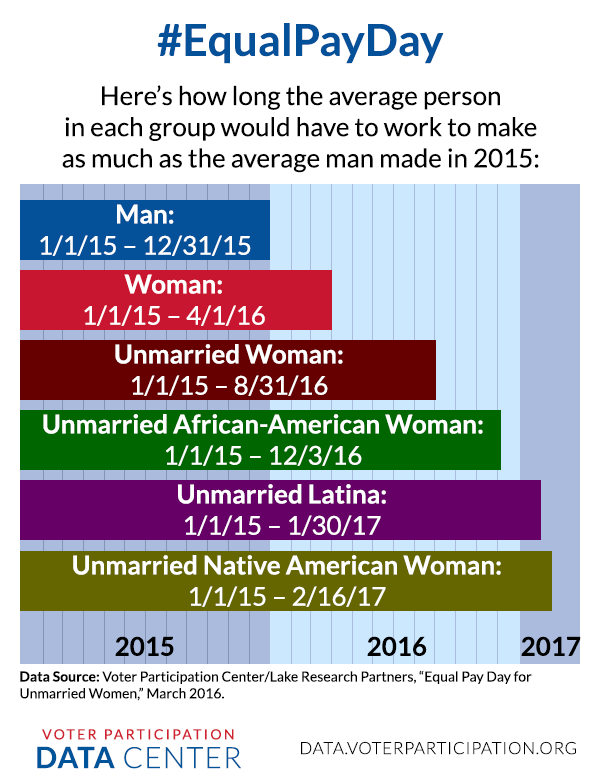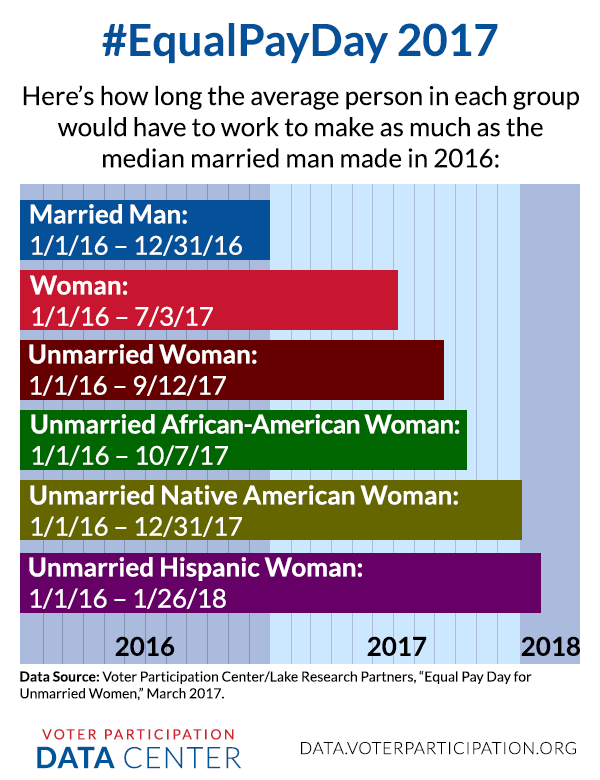Equal Pay Day for Unmarried Women: 2017
54 years after the Equal Pay Act was signed into law, women are still fighting to earn the same earnings as men for equal work. According to the most recent data on 2016 available from the U.S. Census Bureau, women on average make 80 cents for every dollar a man makes.
Earning disparities are even greater for unmarried women, who have seen a steady three-year decline on their earnings in comparison to married men. Unmarried women now earn only 59 cents to every dollar a married man earns, part of an ever-consistent pattern of unmarried women being left behind, even in a growing and improving economy.
In short, there have been no real substantive gains for women. In fact, equal wages is seeing a backwards trend while married men continue to see their earning power grow. Read about the particular difficulties facing unmarried women of color and single mothers and the real, day-to-day consequences of the pay gap.
Downloads
Equal Pay Day 2017: Unmarried Women and the #WageGap
April 4, 2017 is Equal Pay Day 2017 — the date that symbolizes how far into 2017 the average woman has to work in order to make the same amount as the average man. According to 2016 US Census data, the wage gap for 2016 was the same as in 2015: for every $1 the average man is paid, the average woman is paid only $0.80.
Unmarried women are hit particularly hard by the wage gap. For every $1 the average man earns, the average unmarried woman is paid only $0.71… and for every $1 the average married man is paid, the average unmarried woman is paid only $0.59. That means that the average unmarried woman has to work until May 31, 2017 just to make the same as the average man did in 2016, and until September 12, 2017 to make the same as the average married man did in 2016.
And it’s even worse for unmarried women of color: For every $1 the average married man is paid, the average unmarried African-American woman is paid only $0.57, the average unmarried Native American woman only $0.50, and the average unmarried Hispanic woman only $0.48. That means that in order to make as much as the average married man made in 2016, the average unmarried Hispanic woman will have to work until January 26, 2018.
Here’s a state-by-state breakdown of the wage gap for unmarried women. What is the wage gap for your state?
The Wage Gap for Unmarried Women (2016)

Pay Gap by State (2017)
For more details, read the full report from Lake Research Partners and the Voter Participation Center about Equal Pay Day for unmarried women.
Share this post widely on social media to raise awareness of the wage gap and the importance of #EqualPay.
CAP Report: The Pillars of Equity
A new report from the Center for American Progress, The Pillars of Equity: A Vision for Economic Security and Reproductive Justice, explores in detail the reasons that “reproductive health, rights, and justice must be integral to a successful, 21st-century economic agenda” and offers concrete policy recommendations designed to help women achieve economic security and reproductive justice in tandem.
This comprehensive policy approach “requires a policy agenda that promotes self-determination, access to comprehensive and affordable services, parenting supports, and a responsive workplace. This ensures that women—regardless of location, income status, race, sexual orientation, or age—have access to the services and resources they need in a timely, culturally competent, respectful, and affordable way that will help contribute to their economic mobility.”
“An investment in reproductive health means an investment in America’s promise of equality for all. That promise must be as adaptable and expansive as the roles women play in society. Policies and cultural norms must evolve so that women can participate freely in society and use all of their talents to strengthen families. Economic opportunities for women ensure that they can chart their own reproductive destiny and better achieve economic security. When all people are able to achieve their best economic opportunity, the entire national economy thrives and grows.”
NPWF: Not Enough Family Friendly Policies
The National Partnership for Women and Families has released a fact sheet on the state of family-friendly policies that affect the economic stability and well-being of women and families — and the news isn’t good. The wage gap, discrimination on the basis of pregnancy, a lack of paid family and medical leave and paid sick days, unpredictable scheduling and hours, and stagnant wages continue to keep women, particularly mothers, from realizing their economic potential.
The fact sheet concludes with several legislative proposals to improve the economic stability of women and families, writing:
Women, their families and our nation urgently need policies to promote fair pay and create modern workplace standards, bolstering their financial security now and promoting economic opportunities in the future.
Read NPWF’s fact sheet, “Not Enough Family Friendly Policies: High Stakes for Women and Families.”
IWPR: 5 Facts about Women and the Economy
For International Women’s Day and the “A Day Without a Woman” strikes occurring across America, the Institute for Women’s Policy Research has compiled together 5 important facts to know about women and the economy:
1. Hispanic women will wait 232 years for equal pay, if current trends continue.
2. Equal pay would cut poverty by more than half for working women and grow the U.S. economy.
3. Job Segregation keeps 1 in 4 working women in traditional care, serving, and cleaning roles with lowest pay.
4. Women account for only 1 in 3 workers in good, growing, middle-skill occupations.
5. A national paid leave policy could help young working mothers, a group least likely to have access to leave.
Read more from IWPR about these economic barriers women continue to face in our economy.
New Census Data Shows a Huge Gender Gap in Income
The U.S. Census Bureau’s latest report gives undeniable evidence of “a persisting large gender gap in incomes in the United States. The fact that nearly one fifth of all family households are headed by a single woman and that these households have incomes far below the national average, is cause for major concern.”
WIAReport continues, “for single women living alone, the median income in 2015 was $29,022. For single men living alone, the median income was $40,762. Thus, single women had a median income of 71.2 percent of the median income of single men.”
Indeed, the data shows that the median income for households headed by single women in 2015 was $37,797, and that these counted for 19% of all households in America.
EPI: "Women's work" and the gender pay gap
The Economic Policy Institute took an in-depth look at the pay gap, and the factors that cause it. Finding that “Women are paid 79 cents for every dollar paid to men—despite the fact that over the last several decades millions more women have joined the workforce and made huge gains in their educational attainment,” the authors conclude that:
“The gender wage gap is real—and hurts women across the board. Too often it is assumed that this gap is not evidence of discrimination, but is instead a statistical artifact of failing to adjust for factors that could drive earnings differences between men and women. However, these factors—particularly occupational differences between women and men—are themselves affected by gender bias. Serious attempts to understand the gender wage gap should not include shifting the blame to women for not earning more. Rather, these attempts should examine where our economy provides unequal opportunities for women at every point of their education, training, and career choices.”
Equal Pay Day 2016: Unmarried Women, Race, and the #WageGap
Today is Equal Pay Day: a date that symbolizes how far into 2016 the average woman would have to work just to make as much money as the average man made in 2015. Because the average woman makes 80¢ for every $1 a man makes, she’d have to work three extra months—all the way through March 2016—just to make as much as the average man made in 2015.
As we pointed out in yesterday’s post, while the wage gap for women overall is awful, the wage gap for unmarried women is even worse; the average unmarried woman makes only 60¢ for every $1 a man makes.
But unmarried women of color are the ones who suffer the most from the wage gap: For every $1 the average man makes, an unmarried African-American woman makes 52¢, an unmarried Latina makes 48¢, and an unmarried Native American woman makes only 47¢. Those numbers look even worse when we consider how long the average woman in each of those groups would have to work just to make the same amount of money the average man made in 2015:

That’s just depressing.
And it’s not going to change until policymakers at the state and federal level acknowledge that there’s a problem, and take action to solve it. That’s why efforts like Equal Pay Day are so important, to put pressure on officials to do something about the wage gap.
Please do your part and spread the word.
Read the full memo from the Voter Participation Center and Lake Research Partners about the current wage gap and presidential candidates’ response to the wage gap: Equal Pay Day for Unmarried Women (PDF)
Equal Pay Day 2016: Unmarried Women and the #WageGap by State
Tomorrow, April 12, is Equal Pay Day: a date that symbolizes how far into 2016 the average woman would have to work just to make as much money as the average man made in 2015. Women make, on average, 80¢ for every $1 a man makes—a gap that adds up over time, costing the average woman $430,480 in lost income over a 40-year career.
But as terrible as that is, it’s even worse for unmarried women. The average unmarried woman makes only 60¢ for every $1 a man makes.
To find out what the wage gap for unmarried women is in your state, check out this interactive map:
The Wage Gap for Unmarried Women

Pay Gap by State
Yes, the wage gap for women, unmarried women, and unmarried women of color is real—and it’s a problem that won’t go away unless we do something. We need to demand that our policymakers and legislators at the state and federal level take action to end the wage gap.
Read the full memo from the Voter Participation Center and Lake Research Partners about the current wage gap and presidential candidates’ response to the wage gap: Equal Pay Day for Unmarried Women (PDF)
Statistical Profile of Unmarried Women: South Dakota
Our research team has compiled available data from the US Census Bureau, the Bureau of Labor Statistics, and other sources to put together this statistical profile of the demographic and economic circumstances facing unmarried women in the state of South Dakota.


